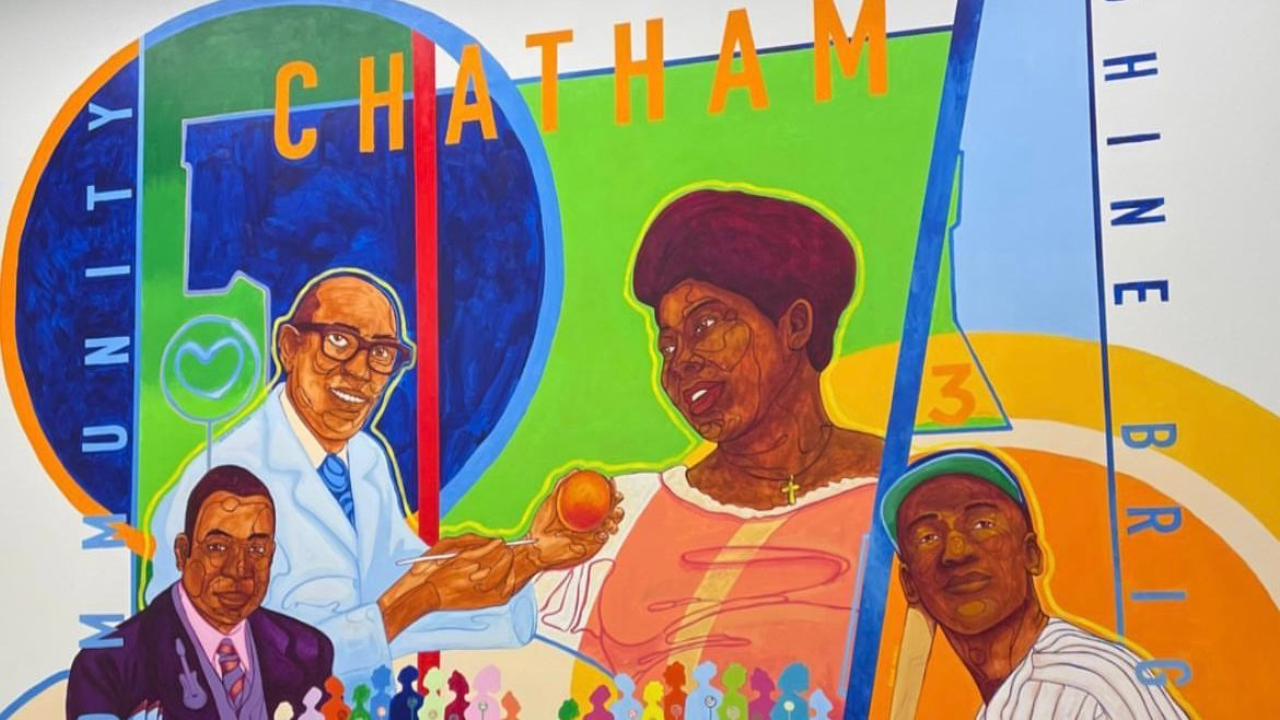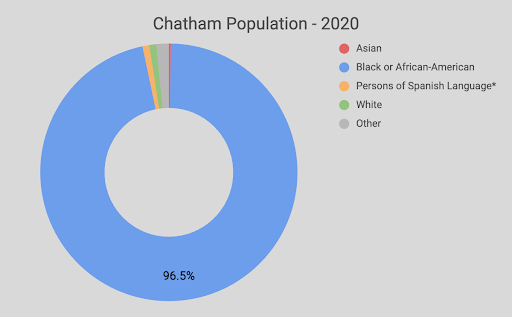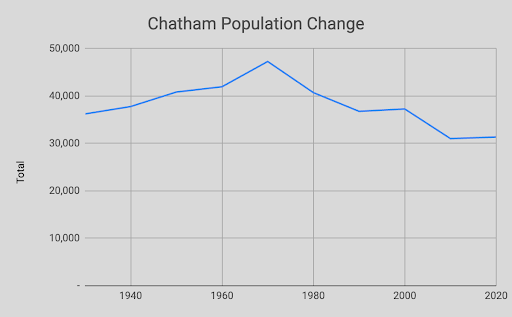Chatham: The Jewel of the Southside
Nov 12, 2025
Introduction
Chatham, officially Community Area 44, sits on Chicago’s South Side, a proud and historically stable neighborhood long celebrated for its strong middle class, civic pride, and vibrant African American culture. Its boundaries stretch roughly from 79th Street to 87th Street, and from State Street east to Cottage Grove Avenue.
Trivia Question:
Which Chatham native served as Mayor of Chicago after the sudden death of the great Mayor Harold Washington?
(Answer at the end of this post.)
Chatham By the Numbers


Origins and Early History
Chatham’s story begins in the late 19th century, when the land was still dotted with rail yards, prairie, and scattered industrial buildings. The area took its name from Chatham, England, and began as a working-class district tied to nearby rail and manufacturing jobs.
The Illinois Central Railroad and Grand Trunk Western Railroad both influenced the area’s development, bringing in Irish, Italian, and Eastern European immigrants who worked on the tracks and in local industries. Streets like 83rd and 87th began filling with modest bungalows and two-flats as the city expanded southward in the early 20th century.
However, it wasn’t until the mid-20th century particularly after World War II — that Chatham truly flourished. As the Great Migration brought thousands of African American families north from the South, many settled first in Bronzeville. When segregation and restrictive covenants began to ease slightly in the 1950s, upwardly mobile Black families sought new opportunities — and Chatham became a beacon for them.
Transformation and Evolution
By the 1950s, Chatham emerged as one of the most prominent examples of a Black middle-class community in America. Doctors, lawyers, teachers, and entrepreneurs purchased homes, built churches, and opened businesses.
The area’s tree-lined streets, brick bungalows, and small front lawns symbolized a sense of ownership and upward mobility that was rare for African Americans in mid-century America. Residents took pride in their lawns, their schools, and especially their local businesses — many of which became legendary.
Among them were Johnson Products Company, founded by George and Joan Johnson, who created Ultra Sheen and Afro Sheen hair care products. Their company, headquartered at 86th and South State Street, became one of the first Black-owned businesses to be publicly traded on the American Stock Exchange a groundbreaking moment in Black entrepreneurship.
Chatham was also home to the Seaway National Bank, founded in 1965 after the closure of a neighborhood bank that had refused to lend to Black residents. Seaway quickly became the largest Black-owned bank in the Midwest, symbolizing Chatham’s economic independence and financial sophistication.
Historical Landmarks and Structures
Seaway Bank Building (645 E. 87th Street)
Founded by local leaders, Seaway Bank represented Chatham’s commitment to self-determination and community reinvestment. Its sleek mid-century design still stands as a neighborhood landmark.
Quaker Oats Factory (801 E. 83rd Street)
A reminder of Chatham’s industrial roots, the Quaker plant provided jobs for decades and anchored the area’s early working-class growth.
Chatham 14 Theaters (210 W. 87th Street)
Opened in the 1990s, this Black-owned movie theater became a cultural hub a space where residents gathered for film premieres, community events, and local festivals.
Historical Figures from Chatham
George and Joan Johnson
Pioneers in the Black hair care industry, the Johnsons built a national brand, Afro Sheen, from their Chatham base. Their success story was featured in Ebony and Jet magazines, both of which shared close ties with Chatham residents and businesses.
Herb Kent (“The Cool Gent”)
One of Chicago’s most iconic radio DJs, Herb Kent lived in Chatham and became the voice of a generation spinning soul and R&B records that defined the city’s sound.
Mahalia Jackson (later years)
While not born there, the Queen of Gospel lived in Chatham during her later years, frequently singing at neighborhood churches and community events.
Edward and Bettiann Gardner
The Gardner family of Chicago founded Soft Sheen Products in the 1960s, creating one of the most successful Black-owned hair-care companies in America. Known for products like Care Free Curl, the family built a global brand that celebrated Black beauty and empowered entrepreneurs across the community.
Historical Events
The Great Migration and Racial Transition (1940s–1960s)
As Black families moved into Chatham, they encountered resistance from some white residents. But unlike many neighborhoods where white flight left devastation, Chatham’s new residents built stability through homeownership and collective pride. Civic groups like the Chatham Avalon Park Community Council (CAPCC) worked to maintain property values and fight redlining, making the area a national model of community self-reliance.
The Civil Rights Movement and Economic Empowerment (1960s–1970s)
Chatham residents were key supporters of civil rights initiatives and local business growth. Black-owned companies flourished, and figures like George Johnson, Ed Gardner and Seaway Bank leaders invested heavily in education, job creation, and housing programs.
Urban Challenges (1980s–2000s)
Like much of the South Side, Chatham faced economic headwinds after manufacturing declined. Still, many longtime homeowners stayed, maintaining the area’s character. Community pride remained strong, even amid disinvestment, thanks to churches, block clubs, and local organizations that refused to let the neighborhood’s legacy fade.
Historical Landmarks and Structures
St. Dorothy Catholic Church (450 E. 78th Street)
A cornerstone of the community, St. Dorothy’s was one of the first parishes to welcome Black parishioners, evolving into a center for social and civic activism during the 1960s.
Nat King Cole Park (8400 S. King Drive)
Named for the legendary jazz musician, this park is a favorite gathering spot and tribute to Black artistry and excellence — ideals long championed in Chatham.
Little-Known Historical Fact
In the 1970s, Chatham residents established one of Chicago’s first neighborhood-based private security patrols, funded and organized by homeowners to combat rising crime. The patrol became a model for other communities seeking to blend local initiative with public safety.
Current Trends and Redevelopment
Chatham continues to balance tradition with transformation. Many of its beautiful brick homes remain owner-occupied, passed down through generations. The neighborhood’s strong block clubs and active community councils continue to fight for investment, infrastructure repair, and small business support.
In recent years, new restaurants and coffee shops have begun opening along 79th and 87th Streets, signaling the next chapter of renewal. Despite the challenges of the post-industrial era, Chatham’s sense of ownership and resilience has never waned. It remains one of Chicago’s most important examples of African American middle-class strength — a neighborhood built by hard work, discipline, and hope.
Conclusion
From its origins as railroad land to its golden age as a hub of Black enterprise and stability, Chatham stands as a testament to the power of community. It has produced entrepreneurs, artists, civic leaders, and educators — people who built something lasting in the face of enormous odds.
For anyone seeking to understand what makes Chicago’s South Side both historic and hopeful, Chatham’s story is essential. It’s not just a neighborhood — it’s a symbol of perseverance, pride, and the enduring belief in the American dream.
Trivia Answer:
Eugene Sawyer was a longtime Chicago politician who represented the 6th Ward, which includes the Chatham community, as alderman for nearly two decades. After the sudden death of Mayor Harold Washington in 1987, Sawyer was selected by the City Council to serve as interim mayor, becoming the second Black mayor of Chicago. His tenure focused on maintaining stability and continuing Washington’s reform agenda, though it was marked by political division and challenges leading up to the next election.
FUN CHATHAM FACTS:
There is the famous Blue House on the corner of 84th & Indiana built to be a small replica of the White House in Washington DC. Here’s a video with the owner and MalikShotYou and a Chicago Magazine article with photos of the interior.
Also, Chatham is known to have some of the most unique and fabulous homes built in mid-20th century modern architecture.. Check out the article and photographs here..
Check out Dilla featuring Rhymefest talking Chatham and the Chicago Bungalow and more here.
Roland Burris is a veteran Illinois politician who made history as the first African American elected to statewide office in Illinois, serving as Comptroller and later as Attorney General. In 2009, he was appointed to the U.S. Senate, filling the seat vacated by Barack Obama. Today, Burris resides in the historic Chatham home once owned by gospel legend Mahalia Jackson, continuing his legacy of public service and community pride. Check out his interview with MalikShotYou here.
Stay connected with news and updates!
Join our mailing list to receive the latest news and updates from our team.
Don't worry, your information will not be shared.
We hate SPAM. We will never sell your information, for any reason.


